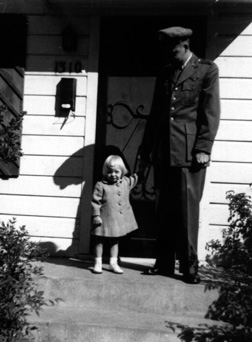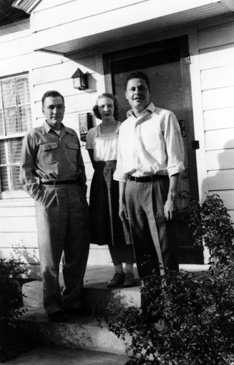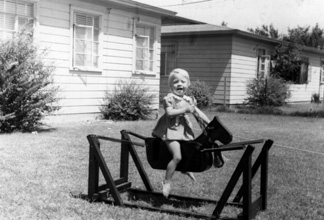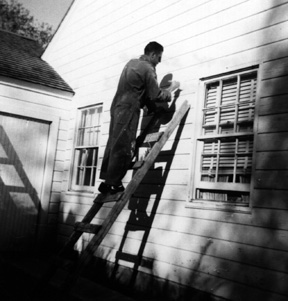Biographical Notes reCharles A. (Chuck) StonePage 2 of 2 Pages, of Chapter 5,RETURN ENGAGEMENT |
|||||||||||
 |
|||||||||||
| Quite soon after our fishing trip, I was notified that my family and I would pack up and move over to Reese AFB, Lubbock, Texas, an advanced twin engine flying training program, where I would get into the serious work of flight instruction. By August of 1951 we had located a house for rent on a quiet residential street and later changed over to a civilian housing duplex apartment in the city of Lubbock. At that time, our next door neighbor family had two children close to the age of Sandy, so it looked like a good arrangement. The father was an Air Traffic Controller who had an injury history of walking into a PT-17 rotating prop earlier in life. He was lucky to still be on his feet. |
|||||||||||
|
on a sunny summer day in Lubbock, Texas |
|||||||||||
| Checking in at the base, I was quickly assigned to the Yellow Tail B-25 section. It seemed of little import, to my new supervisors, that I had never had any serious flying time in multi-engine aircraft. The Operations Officer, who was to become a lifelong friend, Capt. Robert S. Buckley, assigned Capt. Charlie Hodges to give me a fast checkout. While all of this was going on, I was spending as much time as possible familiarizing myself with the cockpit arrangements. In so doing, I encountered a number of newly arrived cadet students who were doing the same thing. Little did I realize that within a few short days some of them would become my four students. Charlie and I got along well and after accumulating about eight hours in the air he signed me off and said to go to work. The first time I walked into the flight room to meet my new students, it was like old home week with my cockpit time friends. My opening remarks let them know that we were going to learn to fly that B-25 together and we were going to have a good time doing it. I had been given the opportunity to fulfill my pledge to be a humane instructor, a pledge made back in 1944, and I was ready to give it a go. I really enjoyed the B-25. It was noisy, beyond belief, but very forgiving, making it a great trainer. You could let your student get in pretty deep before having to save the day with some form of fast correction. |
|||||||||||
| For the next two and a half years it was crash and dash in the B-25. That work did more damage to my long range hearing abilities than anything I ever encountered in my USAF career, and there was plenty of noise to follow even that, later on. On September 10, 1952, Nell gave birth to our son, named David, in the base hospital. He had a difficult start in life, due to an intestinal blockage, but through Nell’s dedicated and innovative care, survived and gradually grew into a robust youngster with a delightful temperament. As the training needs in the USAF evolved, during the Korean War, our mission changed a bit from time to time. There was a period when there was a shortage of fighter pilot trainees, and we switched for a time over to T-6s and then T-28s to finish out some of the classes. It made for some interesting variety in our work and it was a good experience to learn the capabilities of the T-28. At the time, we would never dream that this would eventually become a combat aircraft used in a place called Viet Nam. |
|||||||||||
 |
|||||||||||
|
|
|||||||||||
| Serving as a flight instructor at Reese was a wonderful way for me to really get my feet wet as a more serious pilot. On a couple of occasions, when calls for volunteer assignments came around, I made myself available to go to B-26s in Korea, still having that WW II guilt trip experience. In each case they said they couldn’t afford to loose me as an instructor. A friend was accepted for assignment to the new B-45 program, as a copilot. He and his new crew dropped back in one day to refuel their B-45. They made a high-speed pass on departure that made our hair stand on end. The bad news was that the aircraft blew up enroute to their destination with no survivors. |
|||||||||||
| Flying daily through the changing seasons of the Texas panhandle was an experience, in itself. I can recall flying over Lubbock in a dust storm where we were cruising overhead at 14,000 feet and I could bearly make out the wingtips of the aircraft for the dust. I just could not comprehend how those remarkable engines could keep running on that diet of sandpaper. I think that was the same day we were diverted to Amarillo and I landed the B-25 in a 90 degree, 50 knot, crosswind. What a remarkable, confidence-building experience. |
|||||||||||
 |
|||||||||||
|
|
|||||||||||
| About that time, in the spring of 1952, always being short of money, even with a wonderful finance manager for a wife, I made a deal with our landlord that I would put two coats of white paint on the exterior of our two bedroom rental home in return for two months rent free. We closed the deal and I began painting on free weekends. The day came when I stepped down off the ladder, having just put on the second coat of white paint on the west side of the house. I heard this roaring sound behind me and here came a wall of sand on a wind straight from hell. That side of the house turned to number 60 grade brown sandpaper within about 30 seconds. I had no choice. I let it dry and later put on two more coats of paint. A few years down the road, we received a letter from our old landlord. He said, “Chuck, we have never had paint stay on that house like it did on that west wall.” |
|||||||||||
 |
|||||||||||
|
coat was finished. |
|||||||||||
As we moved into the early spring of 1953, the Personnel Office asked for a volunteer to go to F-94, all weather, upgrade training. I put my name in, thinking that breathing through an oxygen mask on the east coast would be better than sucking down the airborne sands of the Lubbock Cotton Fields. We had a saying that “There wasn't a shovel full of sand in that part of the country that didn't have at least a 100 hours in the air.” Every few days I stopped by the personnel office to check the status of my application. After a couple of weeks delay, they told me that the application had been approved, but an interesting thing had happened. The powers that be had simultaneously submitted me for the Eagle (Korean War Combat Crew pipeline) training program in B-29s at Randolph AFB. I had been selected for B-29s and they had to find a substitute for me to go to F-94s. The next day, walking down a street at the Air Base, another pilot came up to me, shook my hand vigorously and said thanks for getting him that F-94 assignment. Such is life. Nell, Sandy, David and I began to pack for a move to San Antonio’s Randolph AFB and yet another chapter of life. |
|||||||||||
|
End of Page 2 of 2 Pages, Chapter 5 — Go to Chapter 6 Click below to select a destination Go to Page 1 — 2, this Chapter Chapters 1 — 2 — 3 — 4 — 5 — 6 — 7 — 8 — 9 — 10 |
|||||||||||